
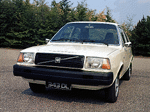
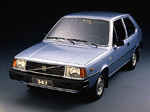
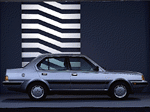
Profile on the Volvo 340 and 360
Peter Neville and Jim Beech
Paradoxically, the story of the 340 does not begin with Volvo at all. Volvo has only occasionally held a controlling interest in the company producing 340s, and we owners might have found ourselves members of the BMW Owners' Club instead. Almost at the same time as the first Volvos appeared around 1927, two Dutch brothers named van Doorne were founding an agricultural machinery workshop. Thirty-odd years later, in 1958 (by when the Volvo 444/544 was well established), the brothers launched their first motor car. A far cry from how it would be today, their car was in gestation for just three years, and its revolutionary transmission, used in every car they made, was a total surprise at the launch. Over the years, two air-cooled models were developed (plus van and pick-up derivatives) and one Renault-engined water-cooled model, and by 1970 the brothers were producing 70,000 cars per annum in their van Doorne Automobiel Fabriek in the Dutch town of Born. In that year they decided to speed up their plans to go to 200,000 cars per annum by finding a partner; meanwhile they would keep their existing range going as long as possible and would drop all of their development programme except for their Project P900. (For P900, read 340!)
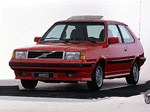
The first P900 design sketches (January 1970) showed a 4-metre 2-door saloon with estate and coupe variants powered by 1.1 and 1.3-litre engines on a 2.35m wheelbase. This notion was soon rationalised into one model, a 3/5-door hatchback, which would be launched in 1975, become the van Doornes' sole model and remain in production for eight or ten years. In April 1971 scale models designed by Michelotti, Provoost (staff), Bertone and de Vries (staff), identified simply as A, B, C and D, were displayed to employees, who voted for D (de Vries). When the de Vries model was also found to fare better in the windtunnel the others were dropped. But meanwhile, the search was on for a suitable partner to share in the P900. In 1970, the brothers had exploratory talks with Volvo, whose car production was twice the number and four times by value that of the brothers. Remarkably, both companies exported 75% of their output. At that time, Volvo was unique in producing a single basic model in large numbers in the upper price level, and wished to diversify downwardly. In many other ways, too, Volvo would be a suitable partner, but Volvo could not finance the brothers' development on top of its own. Another problem was that, while Volvo dealers in the USA were keen to have the P900, the negotiators on both sides (correctly) guessed that the USA's safety and emission regulations would keep the P900 out.
The brothers' discussions with Ford, Peugeot and General Motors (Antwerp) were unfruitful for various reasons. VW did consider the P900, as an entry-level Audi. Nissan considered assembly in Born and joint marketing, while Chrysler considered joint marketing of its Rootes models through the brothers' European sales network. BMW showed considerably closer interest in 1971. The van Doornes' chief design engineer ruefully commented that, as a Francophile with a Danish wife, he would have preferred the Scandinavian-Dutch-French connection of Volvo-van Doorne-Renault than having to hobnob with German engineers who enjoyed nothing more than to boast of their contribution to the V1 rocket. At 160,000 cars, BMW was reaching its production capacity and considered producing the BMW Touring 2002 fastback in Born. And BMW could rapidly develop a 1.4 litre engine for the P900 by downsizing its 1961 1.5 (later stretched to 1.6-1.8-2.0), thus slotting the P900 neatly below the new small BMW 1.6 which was then under development. The BMW stylists wanted to move the P900's transmission from the rear axle to the engine compartment (which would have critically lessened the weight on the rear axle) and to lower the boot line (generating aerodynamic lift on that same-axle). However, before these ideas could be put into effect, the BMW initiative ran into problems, principally because BMW's cash position would not let it put enough money into the P900, and BMW's engine production capacity could not be enlarged enough by 1975 to produce the 1.4.
In 1972, Renault, who were already supplying their 1.1/1.3 engine to the brothers, made the unexpected and welcome announcement that this engine could just be stretched to 1.4 for the P900. This news restored the attractiveness of Volvo to the van Doorne Automobiel Fabriek (note the initials), and in September of that year all speculation about a BMW-DAF link- up was terminated by al1 of official announcement that Volvo would take a one-third share in DAF-Car on 1.1.1973. During this two-year hiatus the P9OO team was able to make good progress, but with the choice of partner resolved and following a shake-up at DAF-Car, the new management at DAF-Car started to have self-doubts about every aspect of the P900 - should it not perhaps be shorter, or longer, or more sporty, or 4-door, or styled after all by one of the famous design studios instead of by DAF staff.... Arguments raged and led to DAF commissioning a rival design from Trevor Fiore, who came up with a youthful-sporty model. Volvo's opinion being that car buyers were becoming less fashion-minded and more rational, Volvo indicated their preference for the de Vries model, but as minority shareholders they refrained from imposing their will outright on DAF. Just when Fiore had completed his high-fashion design at the end of 1972, however, low air resistance started to become a selling point, and as the de Vries model had already been successfully tested in the windtunnel (routine practice at DAF since 1956) and also had more timeless styling, DAF decided to persist with it and dropped the Fiore design, much to Volvo's relief. At 4.2m long with a 2.4m wheelbase, the final design as reached in 1973 remained faithful to the original concept, with (as in all previous DAF’s) rear-mounted rubber-belt stepless automatic transmission driving the rear wheels as the sole transmission option. The 2.4m wheelbase was the maximum possible before a split prop shaft with intermediate bearings would be needed and the wheelbase/length ratio was determined by roadholding and skid-correcting considerations.
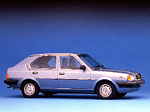
In 1975 Volvo acquired a majority shareholding, the van Doorne family sold out completely and the company was renamed Volvo Car. (van Doorne continued in business as a truck manufacturer and an automotive transmission manufacturer and today supplies steel-belt-drive transmissions for the Volvo 400 series (sic).) Volvo's input to P900 from 1975 onwards resulted in important improvements mainly related to safety (bumpers, safety-belts, windscreen, etc) and more upmarket finish. And Volvo's price upon launch in 1976 was 17,000 Dutch guilders when DAF had planned to charge 14,000! And so, three years after Volvo acquired their first share in DAF and one year after they took full control, the practical yet distinctive 2½-box notchback shape of the Volvo 340, made in Born, was introduced to the world. Truly it was said "VOLVO CAR IS DAF BORN". And like the ugly, it started life with the odds stacked firmly against it. No choice of transmissionit was DAF's 'rubber band' automatic or nought, and no choice of body style. Production of the 340 was 33,000 in the launch year (1976) and nobody really expected the car to sell well, and it didn't. Not that is, until Volvo widened its appeal with a manual gearbox, the option of more doors and the choice of trim. Production then rose, excepting slight dips in 1977 and 1980 to reach a maximum of 116,000 in 1986.
Other versions (5-door, 4-door, 4- and 5-speed manual gearboxes [never contemplated by the original designers, hence the unusual rearward location], 1.7 and 2 litres) were introduced during these years, completing the 300 series range. In 1983, the year's production in Born, at 106,000, at last broke the 99,000 record set by DAF ten years earlier. During this period, Volvo Sweden cut their shareholding in the Dutch operation back to 30%. The Dutch public sector (owners of the other 70%) gained the right to badge their cars as "Volvo" subject to quality and design approval by Volvo Sweden. In March 1988 the millionth 300 was made, but by then production was already on the wane, and the 300 was discontinued after the 1,136,689th on 13 March 1991. This was a metallic-grey grey-upholstered UK-specification belt-drive 340 and thus also the last of some (estimated) 1.16 million rubber-belt drive cars. Dutch Volvo kindly offered me first refusal on it, but on comparison I found I preferred the 1988 gloss white blue-upholstered 340 I already had! Britain proved a strong market for the 300 series, taking (I estimate) 80,000 belt-drive and 300,000 manual examples. (Before that, Britain had taken approximately 60,000 DAF’s, all belt-drive.) Assisted by a keen pricing policy and by a British appreciation of quiet quality above glamour, the 340 reached the "top ten" in British sales for a time.
Perversely, it became fashionable in motoring magazines to sneer at the 340. Remarks abounded (and still do today) such as "a parts-bin model", "driven by ditherers", and "clutters up the road". Given that the 340 comes at or near the top of its class in reliability and safety surveys, these journalists' priorities are open to question. Owners are wiser. They enjoy a well-built highly practical car, one of the sturdiest in the small-medium class and giving the impression of a much larger car. This impression is strengthened by the ease of getting into the high-mounted seat, from which one enjoys a commanding view and feels like the king of the road. One is also king of the car park, as the eye-popping 9.2m turning circle allows one to manoeuvre into the most awkward space. While the brakes are featherlight and instant, the steering is not light, the car cannot be thrown around like a sports car and the suspension is harder than average; one can also sense the engine when it is working hard. To me, these are positive and valuable reminders that one is in charge of a car on the public road and not in a cocooned dream watching the scenery pass. The 1.4 engine with its 72hp is modest by 1994 standards for a 1039kg car but, when teamed with the belt-drive transmission as the designers intended and once in its stride, the engine delivers its power seamlessly to accelerate the car with a reassuringly constant engine note. On the road, the steady and predictable handling encourages craftsmanlike driving, thinking ahead, planning one's actions in advance, surely a good habit for road safety. A journey in a 340 is an event and a pleasure in itself.

Most cars which have sold over a million and have remained in production for fifteen years have achieved a place in the popular imagination, but strangely not the 340. Yet it is well conceived and soundly constructed and will surely outlast many of its flashier competitors. In future years, the truth will gradually dawn that the 340 is a motoring classic.
September 1978: Manual versions became available with a rear-mounted gearbox.
January 1980: 345 five-door hatchback introduced.
September 1982: Models were redesignated 340DL & GL. 360GLS (carburettor) and 360GLT injection) three- and five-door hatchbacks were launched in the UK with a two-litre engine.
May 1985: Previous two-litre GLS hatchbacks were replaced by the GL.
October 1985: Three- and five-door hatchback 1.7GL saloon and five-door hatchback 1.7GLE introduced.
October 1986: 340GL 1.7 saloon introduced into UK.
January 1987: 360GLT saloon launched, in March came the Special Edition 340GLE 1.7 saloon and hatchback.
January 1988: 1.7 limited edition Redline Hatchback launched.
April 1989: 440 launched and the 460 in 1990 heralded the end of the 300 Series. Consequently from 1989 only 1.4 or 1.7 litre engines produced in hatchback form in either base or GL trim.
March 1991: Production ceased.
Legal | Privacy | Contact Us | Search | Site Map
Volvo Owners' Club Limited® 1962-2025

